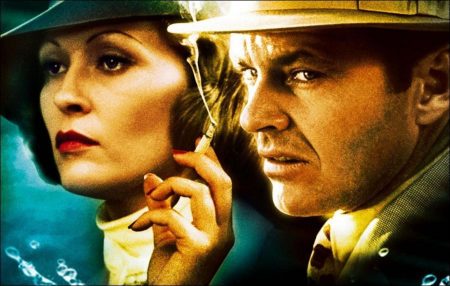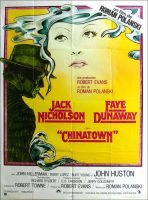Tagline: You get tough. You get tender. You get close to each other. Maybe you even get close to the truth.
Chinatown movie storyline. In 1937 Los Angeles, private investigator Jake ‘J.J.’ Gittes specializes in cheating-spouse cases. His current target is Hollis Mulwray, high-profile chief engineer for the Los Angeles Department of Water and Power, whose wife suspects him of infidelity. In following Mulwray, Gittes witnesses some usual business dealings, such as a public meeting for construction of a new dam to create additional water supply for Los Angeles, as fresh water is vital to the growing community during the chronic drought; Mulwray opposes the dam.
Eventually Gittes sees Mulwray meeting with an unknown young woman who isn’t his wife. Once news of the supposed tryst between Mulwray and this woman hits the media, additional information comes to light that makes Gittes believe that Mulwray is being framed for something and that he himself is being set up.
In his investigation of the issue behind Mulwray’s framing and his own setup, Gittes is assisted by Mulwray’s wife Evelyn, but he thinks she isn’t being forthright with him. The further he gets into the investigation, the more secrets he uncovers about the Mulwrays’ professional and personal dealings, including Mulwray’s former business-partnership with Evelyn’s father, Noah Cross. The identity of the unknown woman may be the key to uncovering the whole story.
Chinatown (1974) is a superb mystery thriller detective private and modern film noir. His original screenplay by Robert Towne is winning a survival which honors the best of Hollywood film noir from the pen of Dashiell Hammett and Raymond Chandler in the ’30s and ’40s. The film has refused to provide a slogan, instead of choosing images with words on his poster, which featured in the Art Deco of the 40s, the detective – his back facing the viewer, to smoke a cigarette, the smoke from to form the face of heroin, meaning creation, mood, and symbolism of the film without uttering a single sentence.
The film is a blend of mystery, romance, suspense and hard boiled detective / film noir genre elements – especially embodied in The Maltese Falcon (1941) (by director John Huston acting in this film) and The Big Sleep (1946 ). This revisionist film noir was the first production from the legendary Paramount Studios head (and former actor), Robert Evans, a flamboyant Hollywood figure who later in 1994 published an autobiography, juicy, stays for children in the photo that been made in a documentary film in 2002.
The film marks the return of French Polish director Roman Polanski in Hollywood five years after the gruesome murders Manson 1969 that claimed the life of his wife, actress Sharon Tate. Polanski chose to use a dark end rather than the final with more hope in the original script, probably because of the tragedies of his life. Only a few years later, in 1978 he would be charged and convicted of statutory rape in 1977 (and drugged) of a young girl of 13 years (later identified as Samantha Geimer), while for star / actor Jack Nicholson (absent at the time), and had to flee to Europe as a fugitive. This was the last film Polanski made on site in the United States.
Screenwriter Robert Towne was founded in part on a real scandal Los Angeles in the early 20th century (the story of the infamous 1908 Owens Valley “rape” scandal and Land San Fernando Valley-grab by speculators). The character of the film, Hollis Mulwray was loosely from the Los Angeles real life water engineer William Mulholland (Director General of the Los Angeles Water Works and Supply), which has orchestrated the purchase of water rights and water piping in the Sierra Nevada in Los Angeles by an aqueduct which crosses the north-precious now San Fernando Valley of Los Angeles. The character’s name was an anagram Hollis Mulwray clever for “Mulholland”. The bad character of Noah Cross was a reference to the Bible, Noah.
Chinatown (1974)
Directed by: Roman Polanski
Starring: Jack Nicholson, Faye Dunaway, John Huston, Perry Lopez, John Hillerman, Diane Ladd, Richard Bakalyan, Roman Polanski, James O’Rear, Nandu Hinds, Richard Bakalyan
Screenplay by: Roman Polanski
Production Design by: Richard Sylbert
Cinematography by: John A. Alonzo, Stanley Cortez
Film Editing by: Sam O’Steen
Costume Design by: Anthea Sylbert
Set Decoration by: Ruby R. Levitt
Art Direction by: W. Stewart Campbell
Music by: Jerry Goldsmith
Distributed by Paramount Pictures
Release Date: June 20, 1974
Visits: 172

